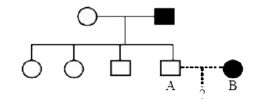A solid with formula ABC3 would probably have
A at body centre, B at face centres and C at corners of the cube
A at corners of cube, B at body centre C at face centre
A at corners of hexagon, B at centres of the hexagon and C inside the hexagonal unit cell
A at corner, B at face centre, C at body centre
The correct Answer is:B
To determine the probable structure of a solid with the formula ABC3, we will analyze the contributions of each atom type (A, B, and C) based on their positions in the unit cell.
1. Identify the Positions of Atoms:
- Atom A: Let's assume atom A is located at the corners of the unit cell.
- Atom B: Assume atom B is positioned at the body center of the unit cell.
- Atom C: Assume atom C is located at the face centers of the unit cell.
2. Calculate the Contribution of Atom A:
- There are 8 corners in a cubic unit cell.
- Each corner atom contributes 18 to the unit cell.
- Therefore, the total contribution of atom A is:
Contribution of A=8×18=1
3. Calculate the Contribution of Atom B:
- There is 1 body center in the unit cell.
- The body center contributes fully (1) to the unit cell.
- Therefore, the total contribution of atom B is:
Contribution of B=1
4. Calculate the Contribution of Atom C:
- There are 6 faces in a cubic unit cell.
- Each face center atom contributes 12 to the unit cell.
- Therefore, the total contribution of atom C is:
Contribution of C=6×12=3
5. Write the Formula of the Compound:
- Combining the contributions, we have:
- A: 1
- B: 1
- C: 3
- Thus, the formula of the compound is:
ABC3
6. Conclusion:
- The solid with the formula ABC3 is correctly represented by the contributions calculated above. Therefore, the probable structure of the solid is consistent with the formula ABC3.
Final Answer:
The solid with formula ABC3 would probably have the structure where A is at the corners, B is at the body center, and C is at the face centers of the unit cell.
- Atom A: Let's assume atom A is located at the corners of the unit cell.
- Atom B: Assume atom B is positioned at the body center of the unit cell.
- Atom C: Assume atom C is located at the face centers of the unit cell.
- There are 8 corners in a cubic unit cell.
- Each corner atom contributes 18 to the unit cell.
- Therefore, the total contribution of atom A is:
Contribution of A=8×18=1
- There is 1 body center in the unit cell.
- The body center contributes fully (1) to the unit cell.
- Therefore, the total contribution of atom B is:
Contribution of B=1
- There are 6 faces in a cubic unit cell.
- Each face center atom contributes 12 to the unit cell.
- Therefore, the total contribution of atom C is:
Contribution of C=6×12=3
- Combining the contributions, we have:
- A: 1
- B: 1
- C: 3
- Thus, the formula of the compound is:
ABC3
- The solid with the formula ABC3 is correctly represented by the contributions calculated above. Therefore, the probable structure of the solid is consistent with the formula ABC3.
The solid with formula ABC3 would probably have the structure where A is at the corners, B is at the body center, and C is at the face centers of the unit cell.
Topper's Solved these Questions
- THE SOLID STATE BOOK - AAKASH INSTITUTECHAPTER - THE SOLID STATE EXERCISE - Assignment (SECTION - B) (OBJECTIVE TYPE QUESTION)
25 Videos
- THE SOLID STATE BOOK - AAKASH INSTITUTECHAPTER - THE SOLID STATE EXERCISE - Assignment (SECTION - C) (PREVIOUS YEARS QUESTION)
41 Videos
- THE SOLID STATE BOOK - AAKASH INSTITUTECHAPTER - THE SOLID STATE EXERCISE - EXERCISE
30 Videos
- THE S-BLOCK ELEMENTSBOOK - AAKASH INSTITUTECHAPTER - THE S-BLOCK ELEMENTSEXERCISE - Assignment (Section-J)
10 Videos
- THERMODYNAMICSBOOK - AAKASH INSTITUTECHAPTER - THERMODYNAMICSEXERCISE - ASSIGNMENT (Section -D) Assertion-Reason Type Questions
15 Videos
Similar Questions
Knowledge Check
Element X forms a chloride with formula XCl4 which is a solid with low melting point. X would most likely be in the same group of the periodic table as
ANaBMgCAlDSiElement X forms a chloride with the formula XCl2, which is a solid with a high melting point. X would most likely be in the same group of the Periodic Table as
ANaBMgCAlDSiA volatile solid soluble I n benzene would probably
Ahave electrovalent bondingBhave covalent bondingCbe a good conductor of electricityDbe a salt
A complex, salt with formula [Co(NH3)6]Cl3 can form a white curdy precipitate with silver nitrate solution. Another complex with same ligands cannot form precipitate with AgNO3 solution. What would be the probable formula of the complex ? Given reasons in support of your answer.
View SolutionElement X forms a chloride with the formula XCl2, which is a solid with a high melting point. X would most likely be in the same group of the Periodic Table as
View SolutionElement X forms a chloride with formula XCI2, which is a solid with a high melting point. X would most likely be in the same group of the Periodic Table as
View SolutionIn the pedigree shown below, individuals with the solid symbols suffers from albinism. You would counsel the couple A & B that the probability that each of their child will have the disease is :-

View SolutionMn2+ forms a complex with Br– ion. The magnetic moment of the complex is 5.92 B. M. What could not be the probable formula and geometry of the complex?
View Solution
